Local News
Youngest survivor of Auschwitz calls for greater Holocaust education efforts
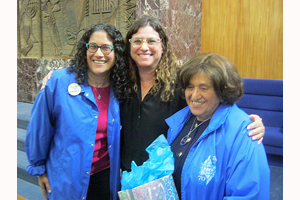
By MYRON LOVE
Angela Orosz-Richt is greatly concerned about the rising tide of Anti-Semitism in the world.
“It seems that the world hasn’t learned anything from the Holocaust,” she said. “There are still a lot of people who believe that all Jews are rich and influential, that we control Hollywood and the media. The internet is full of garbage and we are seeing rising levels and Anti-Semitic attacks in Germany and France and even Brooklyn.
“And it’s not just the old Anti-Semitism. The lies about Israel are outrageous.”
She further noted that half of Canadians can’t name one concentration camp and many don’t know what Auschwitz was.
“There is still so much more (in terms of education) that needs to be done,” she said.
Orosz-Richt has in recent years taken a leading role in Holocaust education. On Thursday, February 27, the youngest survivor of Auschwitz was in Winnipeg for the first time speaking on behalf of the March of the Living to a full house at the Shaarey Zedek Synagogue.
Her appearance in Winnipeg came at the behest of Carrie Shenkarow, chair of the Jewish Federation of Winnipeg’s March of the Living Committee.
Her father was an architect, her mother a well-educated young lady who was raised by French nannies. They met and fell in love and were married in 1943.
“Life was good at first,” she said. “My parents had an active social life. They didn’t see the clouds on the horizon.”
The Germans invaded Hungary in April, 1944, and, shortly after, Orosz-Richt’s parents were removed from their apartment to the ghetto and, on May 22, loaded with hundreds of other Hungarian Jews onto boxcars en route to Auschwitz. Orosz-Richt recounted the standard scenes of yelling, beatings, snarling German shepherds and the presence of Joseph Mengele on the platform designating the new arrivals for life or death.
Prisoners whose lives were spared had their heads shaven, were given uniforms and wooden shoes and were given numbers. “All their dignity was removed,” Orosz-Richt said. “They were no longer counted as human beings.”
While her father was worked to death, her pregnant mother somehow survived. She was first assigned to go through the belongings of victims for anything of value. Then, the five-months pregnant woman was put to work at hard labour building roads. What saved her was a reassignment to kitchen duties where she was able to scrounge potato peels.
When, at seven months pregnant, her condition was brought to the attention of Mengele whose staff subjected her to medical experiments consisting of injecting caustic substances into her cervix.
She was being encouraged by others in her barracks to abort her baby. “MY mother had a dream of her mother telling her to trust in God and not abort her child,” Orosz-Richt said.
She gave birth in the barracks with the help of another inmate who had had some medical experience. Orosz-Richt weighed one kilo at birth and her chances of survival were slim. Further upping the odds against her, almost immediately after birth, her mother had to go outside with the other prisoners for the daily roll call.
“She had to stand for three hours in freezing temperatures in flimsy clothing,” Orosz-Richt said. “It was the thought of her baby waiting inside that kept her going. She was afraid that I might have died before she got back.”
After liberation, mother and sickly child returned to Hungary where they lived with Vera’s mother. Vera found a doctor who looked after her baby. Mother and daughter escaped from Communist Hungary in 1948 and, shortly after, Vera married an older man who had lost his wife and daughter in the Holocaust.
“I grew up with loving and protective parents,” she said.
Orosz-Richt – who has four children of her own – noted that for the first twenty years, survivors didn’t want to talk about what happened to them. For the next twenty years, no one wanted to listen. It has only been in the last 30 years that Holocaust victims are talking and people are listening.
“Holocaust education is so very important,” she said. “Government needs to be involved and we need to start teaching the Holocaust at a younger age.”
Speaking on behalf of the Federation, Jessica Cogan, Israel and Overseas Chair, spoke about the importance of the March of the Living. “I consider the March of the Living a sacred duty,” she said. “My own participation I consider one of the most meaningful moments in my life. It shaped who I am today.”
She noted that the March of the Living began in 1988. Every year, thousands of young people from all over the world gather once a year at Auschwitz, walk the three kilometers from Auschwitz to Birkenau following in the footsteps of the death march near war’s end and show that the world that the Nazi’s failed in their “final solution”. Then they follow up with a trip to Israel where they celebrate Yom Hatzmaut and celebrate the miracle which is the rebirth of Jewish life in our ancestral homeland.
“Our goal this year was to send 20 students from Winnipeg on the March of the Living – 20 in ’20,” Cogan said. “I am happy to announce that we have exceeded that number. We will have 24 students going this spring.”
While the students contribute to the cost of the trip, Cogan noted, the March of the Living Committee raises funds to subsidize those costs.
“We want to thank our donors and encourage others to give,” she said.
Local News
Thank you to the community from the Chesed Shel Emes
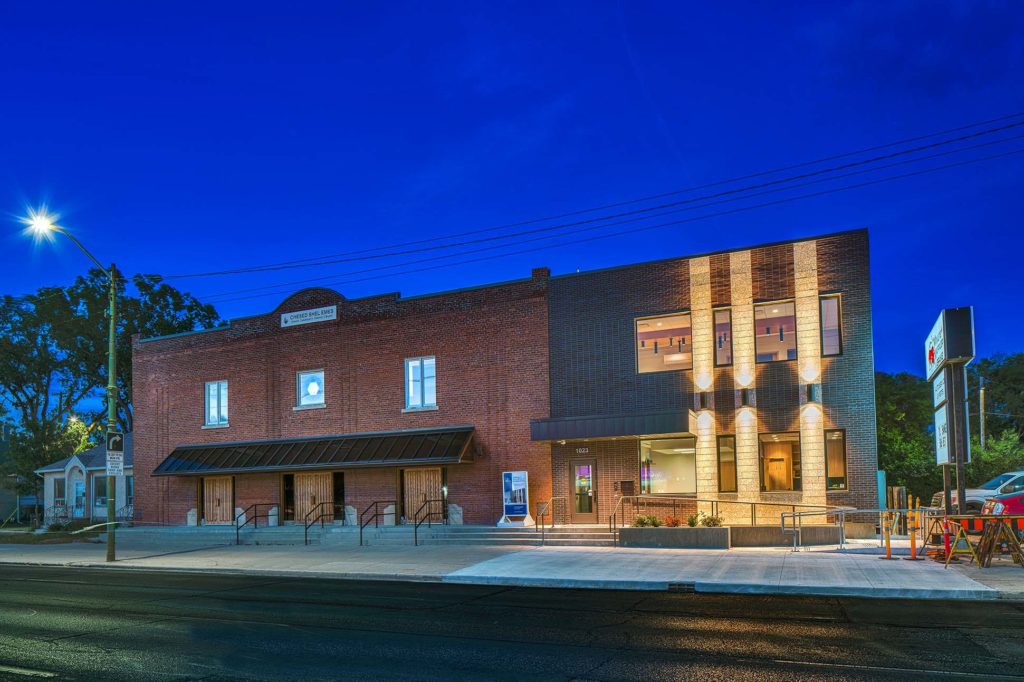
We’re delighted to share a major milestone in our Capital Campaign, “Building on our Tradition.” Launched in November 2018, this campaign aimed to replace our outdated facility with a modern space tailored to our unique needs. Our new building is designed with ritual at its core, featuring ample preparation space, Shomer space, and storage, creating a warm and welcoming environment for our community during times of need.
We’re grateful to the nearly 1,000 generous donors who contributed over $4 million towards our new facility. A $750,000 mortgage will be retired in November 2025, completing this monumental project in just seven years.
We’re also thrilled to announce that our Chesed Shel Emes Endowment Fund has grown tenfold, from $15,000 to $150,000, thanks to you, the Jewish Foundation of Manitoba’s FundMatch program, and Million Dollar Match initiative in 2024. Our fund helps ensure that everyone can have a dignified Jewish funeral regardless of financial need.
As we look to the future, our goal remains to ensure the Chevra Kadisha continues to serve our community for generations to come. Our focus now shifts to replenishing our savings account and growing our JFM Endowment fund.
We’re deeply grateful for your support over the past several years.
It’s our privilege to serve our community with care and compassion.
With sincere appreciation,
Campaign cabinet: Hillel Kravetsky, Gerry Pritchard, Stuart Pudavick,
Jack Solomon, and Rena Boroditsky
Murray S. Greenfield, President
Local News
Winnipeg Beach Synagogue about to celebrate 75th anniversary
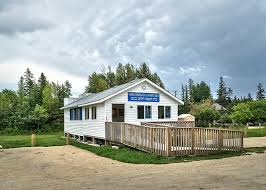
By BERNIE BELLAN (July 13) In 1950 a group of cottage owners at Winnipeg Beach took it upon themselves to relocate a one-room schoolhouse that was in the Beausejour area to Winnipeg Beach where it became the beach synagogue at the corner of Hazel and Grove.
There it stayed until 1998 when it was moved to its current location at Camp Massad.
On August 2nd members of the synagogue will be holding a 75th anniversary celebration.
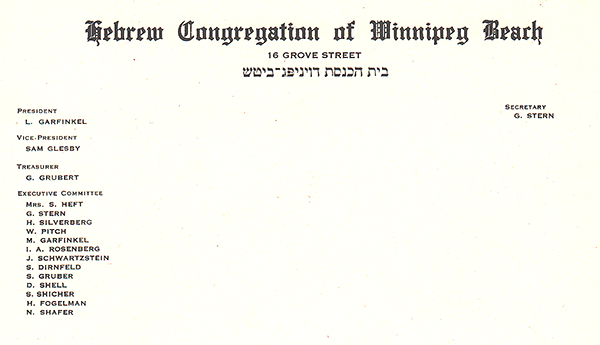
As part of the celebration anyone who is a descendant or relative of any of the original members of the first executive committee (as seen in the photo here) is invited to attend the synagogue that morning.
If you are a relative please contact Abe Borzykowski at wpgbeachshule@shaw.ca or aborzykowski@shaw.ca to let Abe know you might be attending or for more information about the 75th anniversary celebration.
We will soon be publishing a story about the history of the beach synagogue, which is something I’ve been writing about for over 25 years.
Local News
Vickar Family cuts ribbon on new Tova Vickar and Family Childcare Centre
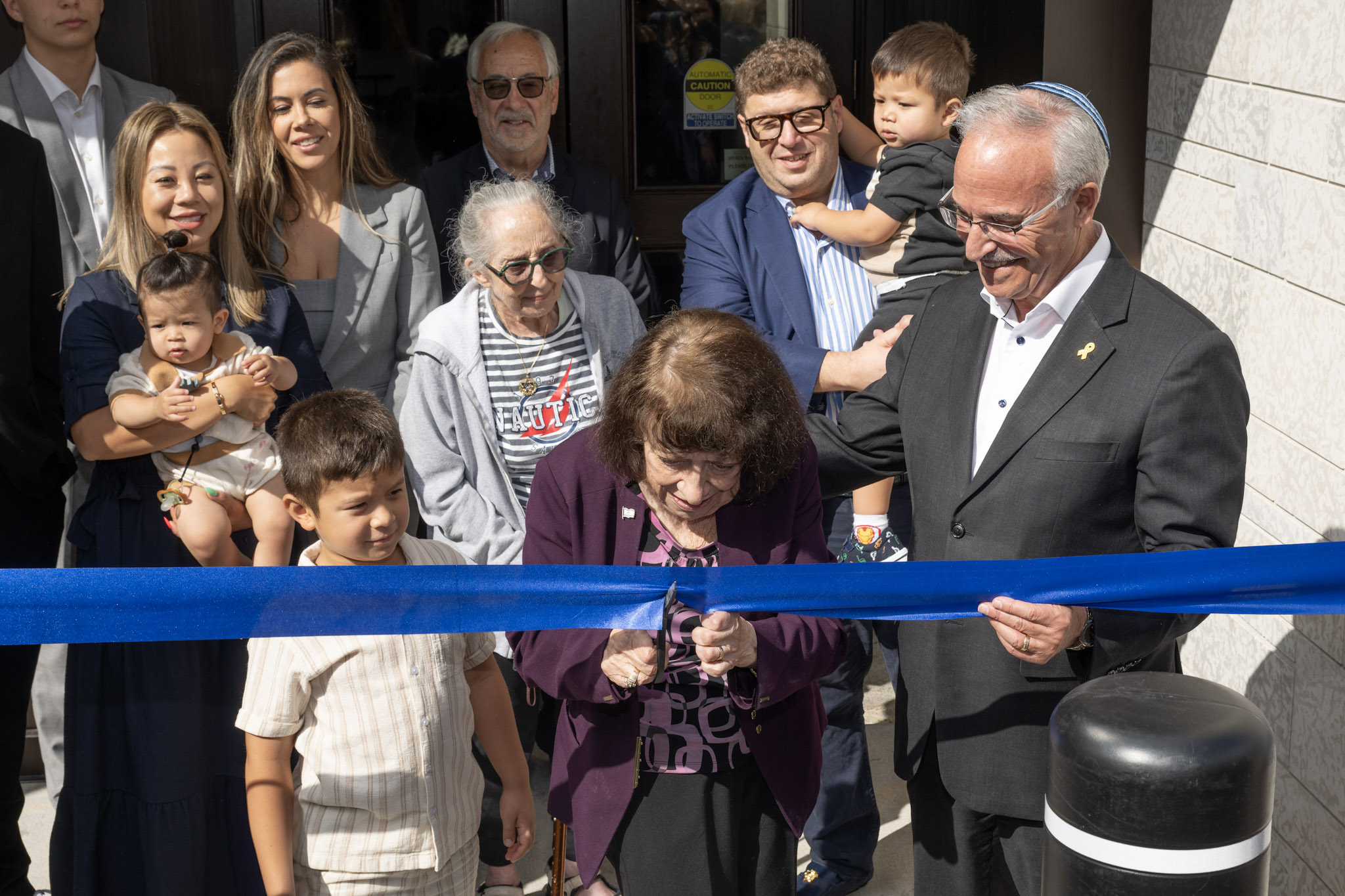
By MYRON LOVE In the words of Larry Vickar, the Shaarey Zedek’s successful Dor V’ Dor Campaign “is not only a renewal of the synagogue but truly a renewal movement of Jewish life in our community.”An integral part of that renewal movement was the creation of a daycare centre within the expanded synagogue. On Monday, June 23, Larry and Tova Vickar cut the ribbon, thereby officially opening the Tova Vickar and Family Childcare Centre in the presence of 100 of their family members, friends and other supporters of the project.
The short program preceding the morning ribbon-cutting began with a continental breakfast followed by a welcome by both Fanny Levy, Shaarey Zedek’s Board President, and Executive Director Dr. Rena Secter Elbaze. In Elbaze’s remarks, she noted that Larry and Tova wanted their family (including son Stephen and family, who flew in from Florida) and friends at the event to celebrate the opening of the Tova Vickar and Family Childcare Centre, “not because of the accolades, but because, as Larry put it, he hopes that their investment in the congregation will inspire others to do the same.”
“When Larry and I spoke about what this gift meant to him and the message he wanted people to take away,” she continued, “I couldn’t help but connect it to the teachings of Reb Zalman Schachter-Shalomi whose book – Age-ing to Sage-ing – changes the whole way we look at the concept of ageing and basing it on our ancestral teachings.”
She explained that his concept of “Sage-ing” is based on three key ideas – Discover your meaning and purpose; accept our mortality and think about the legacy you want to leave.
“Larry spoke about these exact concepts when we met,” she said.
Elbaze also noted the presence of Shaarey Zedek’s newly-arrived senior Rabbi Carnie Rose, former Rabbi Alan Green, and area MLAs Mike Moroz and Carla Compton.
Larry Vickar expressed his great appreciation for all those in attendance. “Tova and I are deeply moved to stand here with you today for this important milestone in our community”, he said. “We are grateful to be surrounded by all of you, the people we care about, our family and friends… you who have touched our lives and played some part in our journey.”
